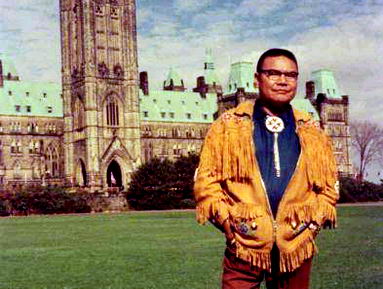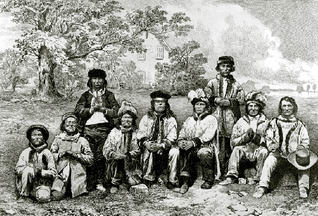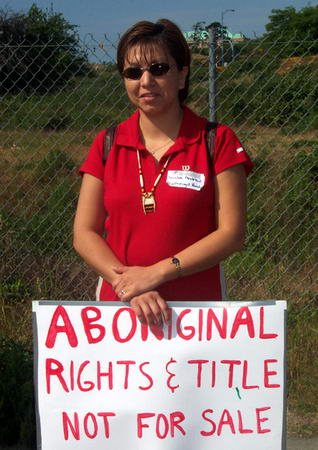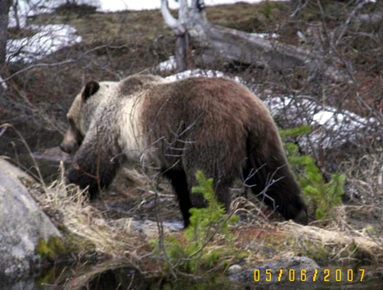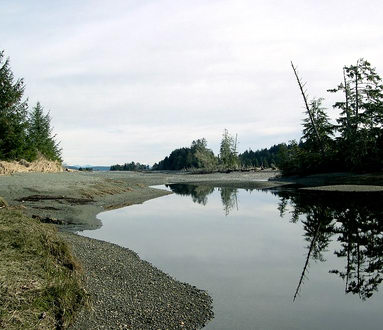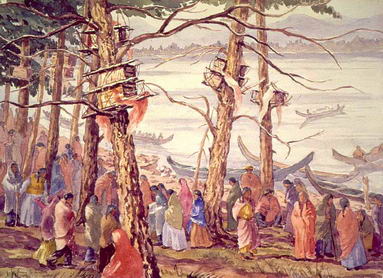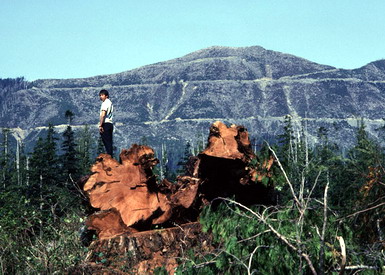 |
|
|||||||
|
||||||||
Most of British Columbia (BC) is unceded Indian land traditionally under the jurisdiction of distinct nations (right). Aboriginal Title is an unresolved issue that creates conflict with settler society over the natural resources. "Our relationship to the land has always been of the greatest importance to our existence. The land is a physical representation of our spirituality. The natural resources must be protected. Our very essence and worldview is threatened by multinational industries such as mining, oil, gas, lumber, and water" Union of British Columbia Indian Chiefs. Secwepemc George Manuel, Ottawa, 1978. |
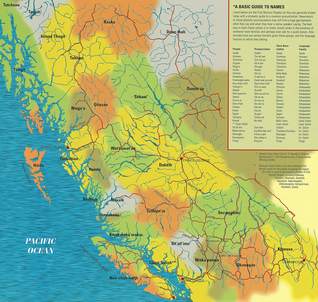
First Nations Peoples. (Click to enlarge) George Manuel (left) was the first president of the World Council of Indigenous Peoples. In 1978 he wrote: "We conclude that our People have no desire, under any circumstances, to see our Aboriginal Title and Rights extinguished. Our People consistently state that our Aboriginal Title and Rights can not be bought, sold, traded, or extinguished by any Government under any circumstances" Aboriginal Title and Rights Paper (Union of BC Indian Chiefs). |
|||||||
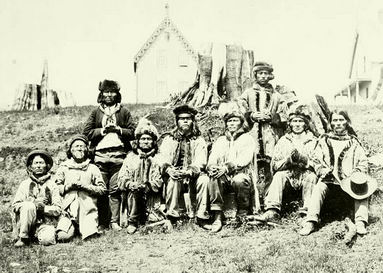
First Nations chiefs, 1867. (Click to enlarge) In fact, the Secwepemc and St'át'imc chiefs have never recognized British sovereignty nor have they ever extinquished their Aboriginal Title and Rights to their land and resources. Seated, from left: Na - nah, Dog Creek; Quil - quailse, Alkali Lake; Se - as - kut, Shuswap; Timpt khan, Babine Lake; Silkosalish, Lilloeet; Kam - eo - saltze, Soda Creek; Sosastumpi, Bridge Creek. Standing, from left: Ta - o'task, Canoe Creek; William, Williams Lake. |
A photo of a group of Secwepemc and Cariboo chiefs is dated 24 May 1867 (left). It was taken at New Westminster, the capital of the new colony which had been named by Queen Victoria when it was founded in 1859. The photo was engraved for the British illustrated press (below). Artistic changes included replacing the massive stumps of logged cedar trees with picturesque English oaks. The scene was intended to show BC Indians celebrating the birthday of Queen Victoria and is an early example of colonialist appropriation. First Nations chiefs, 1867. Engraving. |
|||||||
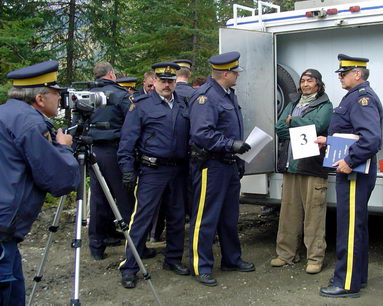
RCMP arresting a Secwepemc activist, 2003. |
Today many generations have passed, yet no treaties have been negotiated and the Indian land question remains unresolved. The ancestors of the Secwepemc chiefs continue to assert their Aboriginal Title and Rights. Many Secwepemc have been arrested by the RCMP for taking a united stand against the ski resort built by Sun Peaks Corporation on contested Indian land at Skwelkwek'welt in Secwepemc Territory (left).
Resort developments on First Nations territories are a growing source of conflict. In 2002 an official complaint was made by the elders, land users and native youth of Skwelkwek'welt to the International Olympic Committee regarding indigenous concerns over the environment, Aborigional Title and Rights and Vancouver's 2010 Olympic bid. The document appears on a German website which supports Indian resistance and human rights: Stopp Sun Peaks. |
|||||||
Skwelkwek'welt Protection Centre was founded in 2000 to protect the area from encroachment by Sun Peaks Resort. Spokesperson Janice Billy (right) says that as a result of the Centre, Secwepemc activists have been subject to repeated court injunctions, charges and arrests. See subchapter: Skwelkwek'welt. On 28 June 2007 Secwepemc activists held a press conference in Vienna to protest against the Austrian Olympic Ski Team for training on contested Indian land at the Sun Peaks Resort and for disregarding the United Nations Convention on Human Rights. See the German Press Release: Arbeitskreis Indianer Nordamerikas. Resort development is also threatening a pristine valley in St'át'imc Territory where a protection camp was set up by grassroots indigenous activists. In 2006, its 6th anniversary was celebrated. See subchapter: Sutikahl. 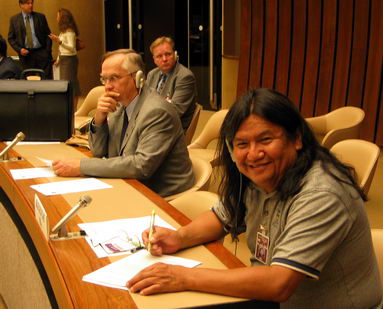
Sepwepemc Arthur Manuel, UN, Geneva, 2004. |
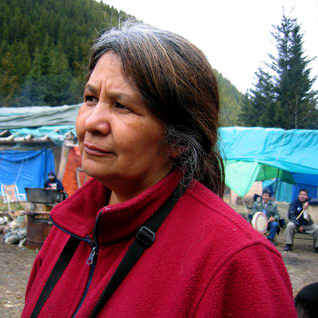
Sepwepemc activist Janice Billy, Sutikalh, 2006. Secwepemc activist Arthur Manuel continues the international fight of his father, George Manuel. As spokesperson of the Indigenous Network on Economies and Trade (INET), he attended the 6th session of the United Nations Permanent Forum on Indigenous Issues in 2007. The preceeding year Arthur took part in the UN Committee on Economic Social and Cultural Rights and in 2004 he participated in the 4th Session of the UN Forum on Forests in Geneva (left). "Canada's policies, especially those aiming at the extinguishments of our land rights, economically marginalize our peoples and violate our human and indigenous rights." See INET's critique of the BC treaty process: Treaty Negotiating Times (5MB). |
|||||||
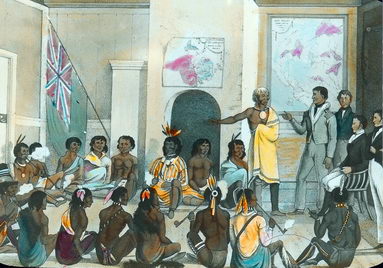
"An Indian Parley," early 19th century. |
The British Royal Proclamation of 1763 was designed to solve the problem of private transfers of Indian land in North America. It decreed that there were to be no sales of such land to individual settlers: instead, Indian land was to be surrendered to the Crown through a treaty process. In other words, the document confirms the existence of Aboriginal Title and Rights which only could be extinguished by means of a treaty.
Visual representations of the British colonization of North America showed a just process in which the Indians took part as equals (left). In reality, treaties were no more than rubber stamps for the legalized stealing and plundering of Indian land. In BC, where most of the land is unceded and without treaty, First Nations retain their jurisdiction according to British law. |
|||||||
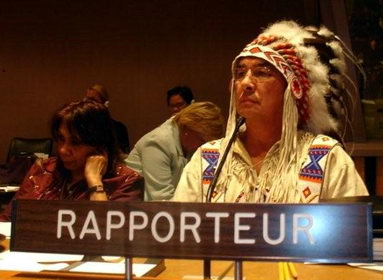
UN Rapporteur Chief Littlechild, 2007. |
Chief J. Wilton Littlechild of the Ermineskin Cree Nation in Alberta represents Canada on the United Nations Permanent Forum on Indigenous Issues: UNPFII. He was Rapporteur for the 6th Session: Territories, Lands and Natural Resources held in May 2007 (left). The Ermineskin Cree Nation signed Treaty Six in 1876 with Queen Victoria. When the Ermineskin have a grievance over the violation of their treaty, they address it to the British monarch and not to Canada. Deceitfully, Canada has been one of the very few nations to refuse signing the United Nations Declaration on the Rights of Indigenous Peoples: Declaration. Until Canada recognizes that treaty rights are both human rights and collective rights, there will be no resolution to the ongoing conflicts between First Nations and the state of Canada. |
|||||||
| Taiaiake Alfred is a Kahnawake Mohawk educator and writer and the founding director of the University of Victoria's Indigenous Governance Program (right). He accuses those celebrating the 400th birthday of America in 2007 as turning a blind eye to the genocide of the continent's native people:
"It's hard for a native person to be anything but shocked and saddened to the core by the effrontery of it all. Jamestown 2007 is, in essence, a surreptitious celebration of the conquest of our homeland and the destruction of our people in the service of imperialism and the expansion of the white race. It marks the era that saw indigenous peoples ravaged by diseases introduced by European settlers (on average, our communities lost 75 per cent of their populations) and the dispossession of our homelands by fraud and deceit - not a single treaty entered into by the English Crown or the US has been honoured by the whites" Why revel in birth of imperial monster? Editorial by Taiakake, 11 May 2007, The Times Higher Education Supplement. Aboriginal Title and Rights Rally, Victoria, BC, 2004. On 20 May 2004 an Aboriginal Title and Rights Alliance Rally was held at the BC Legislature in Victoria (above and right). About 2,500 First Nations elders, leaders, youth and community members protested the government's lack of good faith in resolving land and sovereignty disputes. The BC treaty process has produced few if any satisfactory compromises, accommodations or negotiated agreements. Regrettably, it seems that only direct action such as road and railway blockades makes the powers that be - big business and government - sit up and pay attention to the demands of First Nations and their non native supporters. |
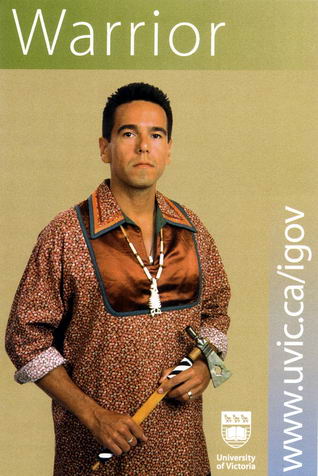
Kahnawake Mohawk Taiaiake Alfred. Canada's so called "Indian Problem" is caused by the illegal occupation of First Nations land by settlers. The dilemma results from the colonial state's failure to resolve the issue of the indigenous peoples' right to own and use their lands and resources. Aboriginal Title was confirmed in 1997 by the Supreme Court of Canada decision: Delgamuukw v. BC. In BC, where only a tiny fraction of the land is under treaty, land rights are most contentious.
Aboriginal Title and Rights Rally, Victoria, 2004. |
|||||||
Thus involved in the First Nations land rights issues are several different but related grievances. First, there has been the humiliating imposition of British supremacy that went with colonisation. Photos that denigrated First Nations people as nameless and powerless subjects were common. Second, there was the shameful treatment of Indians in early treaties by means of which valuable land was obtained "for an apple and an egg," amounting to theft. As indigenous protesters frequently state: there can be "No Justice on Stolen Land" (right). Third, there has been widespread duplicity of settlers who have refused to stick to treaty agreements. Fourth, white settler society has flouted its own treaty laws if obeying the law meant that greedy land grabbing would have to be curtailed. Fifth, Canadian and in particular BC governments, in cahoots with corporate interests, have been following a devious and destructive policy of "divide & conquer," playing Indians against Indians by offering divisive and corrupt deals, luring some poverty struck natives into accepting bribes and jailing others for standing up for their rights. |
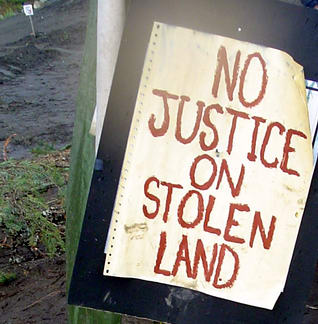
"No Justice on Stolen Land," protest placard. |
|||||||
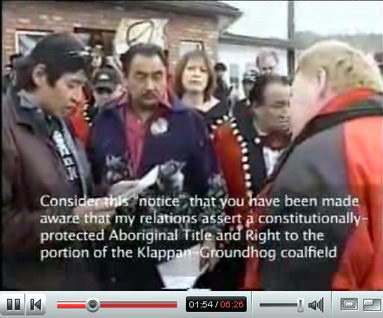
"Saving the Sacred Headwaters," 2005. (Click to play) |
Iskut activist Oscar Dennis is a spokesperson for the Tl'abanot'in Clan. On 2 March 2005 he asserted his Aboriginal Title and Rights by delivering a notice of eviction to Shell officials, while Iskut chiefs James Dennis, Mary Quock and Louis Louie looked on (left). See the documentary video: Saving the Sacred Headwaters. Royal Dutch Shell's coalbed methane project on unceded Tahltan Territory is vigorously opposed by the Iskut elders. See: Klabona Keepers. Shell's industrial mining site it located next to the headwaters of three great salmon bearing rivers, the Nass, the Stikine and the Skeena. When Talhtan elder Lillian Moyer was arrested for a second time at the Klabona blockade, she said: "I am being arrested today for the people of Iskut, for the people of Telegraph Creek, and especially for our grandchildren. This is from my heart. I believe my ancestors are speaking through me." |
|||||||
Chief Saul Terry is a member of the St'át'imc Chiefs Council. A portrait of Chief Terry (right) by Kwakwala artist David Neel was published in his book Our Chiefs and Elders (1990). Saul Terry was trained as an artist and in 1978 he produced a rock painting as a protest action against Canada. See subchapter: Ucwalmicw. Chief Terry believes that the St'át'imc people have the right to benefit from their resources instead of suffering third world living conditions, But in 1998 he made a notable statment rejecting the treaty process as a way to achive justice: "We are being asked to give our consent to eradicating or renouncing that we are distinct Peoples, with distinct identifiable territories, with our own governing systems, with our own distinct languages and histories. We are being asked to use our power of consent to deny to our future generations the benefits of Title from their homelands. The traditional leadership, along with ordinary Indigenous People, have been usurped by neocolonial leaderships that are working with the settler governments to bring this aberration of settlement to a final conclusion. This is not self determination, this is permission to be self administering Canadian laws and systems" 30 November 1998, Vancouver Sun, SISIS Archive. |
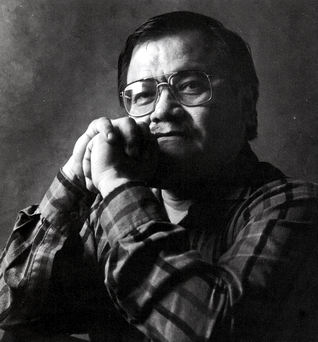
St'át'imc Chief Saul Terry. |
|||||||
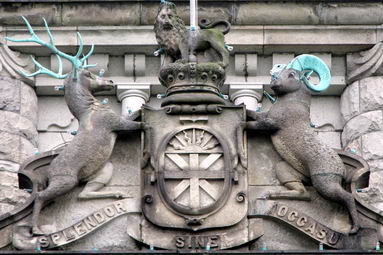
British Columbia Legislature portal. St'át'imc activist Carol Thevarge displays the First Nations version of the BC flag at a protest over the logging of the N'Quatqua forests in May 2007 (right). She explains: "If you look at a BC flag today, the union jack is on top of the sun and rivers to symbolize the British Crown. I am not sure how many people know about the original version, but the N'Quatqua elders told me to invert the flag and put it the right way again. So I cut the flag in half and sewed it back with the sun on top." Thevarge also displays the Mohawk Warrior flag because, she says: "The Mohawks were our stronghold, they are the east gate that held the Europeans off for over 100 years and kept them from coming West. They are our big brothers and sisters that took care of us in that way. I will honour them whenever we make a stand, their flag will fly along with the original BC flag." According to Randy James, a St'át'imc whose grandfather signed the Declaration of the Lillooet Tribe in 1911, "Our Chiefs of that day realized what and how the world was defining a sovereign Country so declared us a Country using the word as they understood it at the time. The Declaration constitutes the Government of the Country, the Estates the Government rules over, the Peoples, the history of Defence and War of the Country, and the Sovereignty." |
Supremacy problems have been revealed by the controversy over BC's coat of arms, originally designed to appeal to Queen Victoria (left). Here the coat of arms is carved in stone above the main entrance to the Legislative Building in Victoria, the capital city of BC. The splendour of BC's natural wealth is represented by the wapiti stag and the bighorn ram while the western location of BC is indicated by the neversetting sun, positioned above the union jack on the shield. St'át'imc Carol Thevarge, 2007. |
|||||||
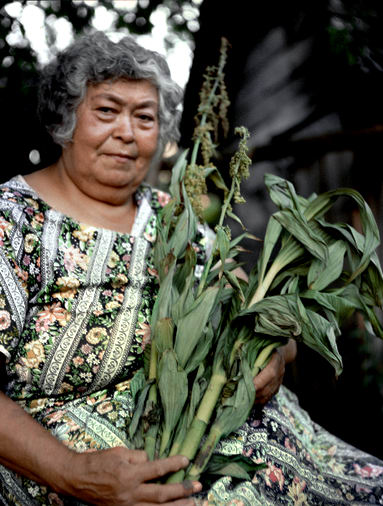
Nuxalk Matriarch Margaret Siwallace, 1978. |
Traditional ecological knowledge is enormously important to First Nations sovereignty. Born in the ancient village of Kimsquit, Margaret Siwallace (1908 - 1985) was a Nuxalk Nation matriarch and chieftainess with a profound knowledge of traditional plants and culture (left). Here she is holding a bundle of Hellebore, a powerful healing plant in Nuxalk medicine, also eaten for medicinal effect by the local Bella Coola bears. In 1985 Margaret Siwallace became the first person of Nuxalk Nation and the first aboriginal woman at the University of British Columbia to receive an honorary doctorate. This was in recognition of her extraordinary sharing of invaluable Nuxalk knowledge ensconced in aural tradition with an international body of social scientists, thereby contributing to the permanent documentation of a vast corpus of Nuxalk culture, including the endangered Nuxalk language. Margaret's great grandson, Spencer Siwallace, was elected Nuxalk Chief Councillor in 2007. "The Nuxalk currently have two governing bodies, the traditional government, through the Hereditary Chiefs, and also the colonially rooted Indian Act elected Chief and Council, imposed by the government of Canada" Nuxalk Nation. To bring international attention to the threat facing their culture by the vanishing eulachon, the Nuxalk organized a "Feast of Shame" in June 2007. |
|||||||
Qwatsinas (Edward Moody) is a hereditary chief of the Nuxalk Nation (right). His teachers of traditional knowledge were his grandmothers Margaret Siwallace (above) and Felicity Walkus and his mentor Willie Hans. In 1999 Qwatsinas toured Germany with a group of Nuxalk to rally international support against the plundering of their homeland by Interfor (International Forest Products). See: Kultur statt Kettensaegen. Without the rich temperate rainforest biodiversity that gave rise to the remarkable Nuxalk culture displayed at museums around the world, the Nuxalk people will lose their identity. Traditional knowledge of plants and animals, of hunting and fishing, is disappearing along with the ancient cedar trees, grizzlies, salmon and eulachon. Qwatsinas has witnessed the clearcut logging of watersheds in Nuxalk Territory that once produced some of the world's largest grizzly bears. He fears that the magnificent animals have nowhere else to go as their habitat continues to shrink. While returning home to Bella Coola in June 2007, Qwatsinas photographed a grizzly seen from the road (below). For non natives, the grizzly represents the wilderness, but for the Nuxalk, the grizzly is an integral part of their culture. Grizzly near Bella Coola, 5 June, 2007. |
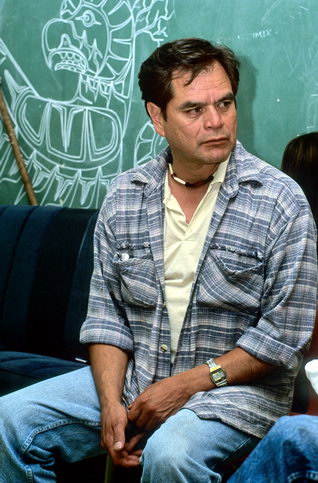
House of Smayusta Chief Qwatsinas, 1997. Nuxalk elder Clayton Mack (1910 - 1993) recorded the wanton destruction he had witnessed in his lifetime: "Why does the government have to kill so many trees and kill them so fast? Trees have been there hundreds and hundreds of years, why them white guys want to cut them all down in less than fifty years? What is the rush? Why are those white guys so damn greedy? Why does the government want to do that to all the grizzly bear and salmon river valleys? . . . Indians don't do nothin', can't do nothin', we just sit and watch the white men do that to the land" Clayton Mack. |
|||||||
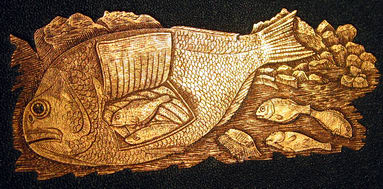
Gilt engraving on book cover. Since the colonization of BC in 1867, the government has enforced policies that separate the aboriginal peoples from their fisheries. During the rapid conversion of aboriginal fisheries to an industrial and commercial fishery by settlers, there were many disputes. The rights of the aboriginal fishers preceded the British assertion of sovereignty, but First Nations were excluded from owning commercial fishing boats or canneries and did not profit from the lucrative coastal cannery industry except as labourers (right). The Supreme Court of Canada has recognized a constitutional right of aboriginal peoples to a food, social and ceremonial fishery, yet conflict continues as a consequence of the unresolved issues of Aboriginal Title and Rights. See: Aboriginal Rights to Fish in BC (Scow Institute). High profile politicians including the Prime Minister of Canada and the Minister of Indian Affairs have provocatively flamed the Indian land issues by publicly asserting in 2007 that the aboriginal fishery is "race based," refusing to acknowledge that it is based on the use and management of Indian possessions from long before British colonization. |
As early as 1866, a member of the British Boundary Commission wrote in his travel account: "Salmon is of the most vital importance to the Indians: deprived or by any means cut off from obtaining it, starve to death they must; and were we at war with the Redskins, we need only cut them off from their salmon fisheries to have them completely at our mercy" The Naturalist (left). 
Fraser River cannery, 1898. |
|||||||
Surveyed boundaries are a European practice forced onto Indian land as it was stolen and settled without legal title. The relationship of First Nations to the land is embedded in the ancient tradition of shared and permeable boundaries which weave together ecology and culture. This tradition has survived despite the duplicitous "divide & conquer" tactic by the government. Under the cover of boundary disputes and treaty talks, it continues to give away Indian land to corporations for resource extraction and development. The new industrial site of Polaris Minerals, called Orca Sand & Gravel, is on contested Indian land that is part of the Cluxewe watershed (below). Kwakiutl Buster Wilson protested: "How can we First Nations protect our land through Archaeology and Pre Historic Land Bases? There are many historical land bases that are not being properly looked into. We need to protect our rivers for our ancestors who always used the rivers for survival ... We need to stop this mining and the continued stealing of our history away from us" BC Environmental Assessment Office. Ancient Kwakwala site at Cluexwe River, 2006. |
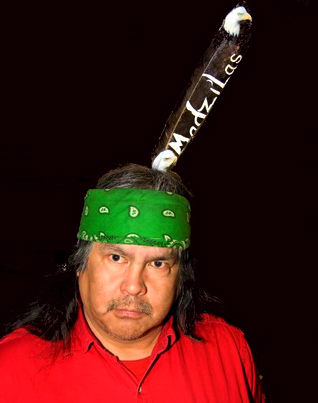
Kwakiutl Buster Wilson, 2005. Buster Wilson is one of the nine Kwakwala speaking sons of Kwakiutl Chief Robert Wilson and Annie Martin of Tsaxis (Fort Rupert). In 2005 Buster took part in a funeral service for his brother, Albert Spruce Wilson (1939 - 2005), also known as Madzilas. He wore an eagle feather painted by a Kwakwala artist that was used as a pen for signing the book of remembrance (above). Buster is concerned about the aggregate industry exploitation of the Cluxewe watershed where Polaris is excavating an entire hillside ridge for shipment to California. To facilitate this massive removal, Polaris has constructed a deep sea tanker port near the mouth of the Cluxewe River, an ancient Kwakiutl village and fishery site (left). |
|||||||
The German anthropologist Franz Boas was inspired to study the Northwest Coast tribes after seeing a collection of artifacts in Berlin. These objects had been "collected" in the 1880s by the Norwegians Johan Adrian Jacobsen and Bernard Filip Jacobsen on the behalf of Adolf Bastian, director of the Royal Museum of Ethnology. See chapter: Kwakiutl. Among the Kwakiutl objects was a transformation mask representing the sun (right). This was the beginning of the lucrative trade in aboriginal art and artifacts that hugely benefited all but the peoples whose numbers were plummeting while they were being robbed of their cultures and homelands. The academic anthropologizing of the Kwakiutl has not saved them from dispossession. Few if any Western scholars have combined their ethnological studies of First Nations with activism to help protect them from the rape, pillage and poisoning of their land and waters. Kwakiutl Chief Rupert Wilson, 2005. |
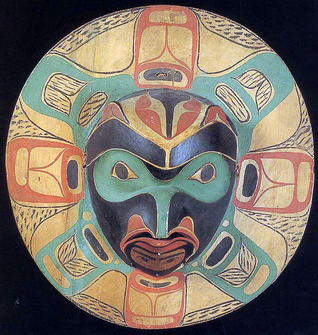
Kwakiutl transformation mask, c. 1881. Rupert Wilson is both an elected and a hereditary Kwakiutl chief and Kwakwala speaker (left). He puts the blame for the demise of his people squarely on the shoulders of the government of Canada. He has seen how in three generations the Kwakiutl have been reduced to living on government handouts. Kwakiutl employment in the logging industry ceased when union restrictions were unilaterally imposed and fishing as a Kwakiutl way of life ended when punitive laws were inacted to serve the commercial fishery. Chief Wilson warns that the current replacement of fishing by aquaculture is the final blow to the economic independence of many indigenous coastal communities in BC. He sees the rise of this destructive industry as part of the longstanding and underhanded government plan to extinquish the Aboriginal Title and Rights of First Nations. |
|||||||
The shocking failure of BC's Heritage Conservation Act to protect indigenous sites has resulted their looting and desecration. Chief Rupert Wilson remembers walking along Storey Beach at Tsaxis as a boy and finding skulls (right). These human remains came from the Kwakiutl burial practice of interning their dead in wooden caskets which were lashed to the high branches of trees, as depicted in a c. 1920 watercolour (below). Also the enormous and ancient shell middens at Tsaxis - evidence of occupation over thousands of years - were removed by the government in the 1980s to construct the runways of the nearby Port Hardy airport. Storey Beach, Tsaxis. Painting by J. Wilson, c. 1920. |

Storey Beach, Tsaxis, 2006. Beaver Harbour is the site of Fort Rupert, one of the first Hudson's Bay Company posts in BC. Today only a pile of rocks remains of the failed colonial outpost while the Kwakiutl people continue to live here. They are determined to regain control over all of their territoryby initiating legal action against the divisive land grabs by various corporations such as Omega (now Pan Fish), a fish farm company owned by the Norwegian mega corporation Cermaq, which has polluted Kwakiutl waters with its industrial operations at Hardy Bay and refused to provide compensation to the people who lost their livelihood. |
|||||||
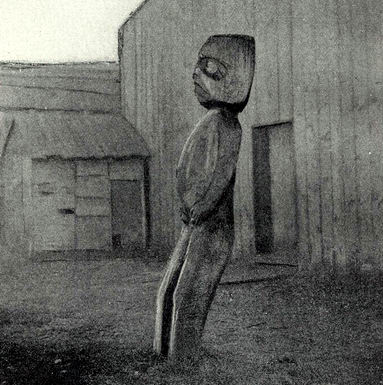
Killer Whale, Fort Rupert. |
Scandinavians like to think of themselves as leaders in human rights yet the Norwegians take part in the ruining of the wild salmon stocks on which the indigenous peoples of BC depend. Why is Canada not protecting them from the plundering of international resource corporations? It is left to First Nations themselves to stand up to the monster Goliath of greed and government - big business corruption. In 2007 Canada committed to saving the Southern Resident
Killer Whales. See: Recovery
Strategy. It is nothing but rhetoric, a cynical overture to the demise
and disappearance of one of the most magnificent species on Earth, which
had been stewarded and celebrated for thousands of years by indigenous
peoples. Yet within
100 years of colonization the killer whale
was almost wiped out. |
|||||||
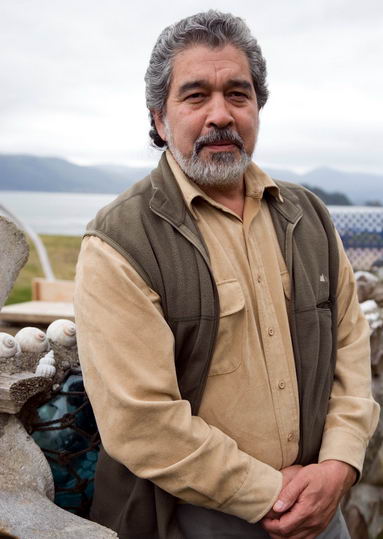
Guujaaw, Haida President, 2007. |
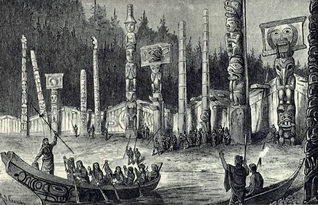
"Ein dorf der Haida Indianer." (Click to enlarge) Along with the Kwakiutl and the Nuxalk, the Haida were the most famous of the North American Indian tribes. Their spectacular totem poles and villages were widely represented in the popular press in Europe. Above is an illustration of the Haida village of Skidegate by the well known German artist Rudolf Cronau, c. 1881. Haida carver and forest activist Guujaaw is also the long time president of the Council of the Haida Nation at Skidegate, Haida Gwaii (left). For over three decades Guujaaw has fought to protect the old growth forests of Haida Gwaii. In 2004, he led a pivotal legal case against the BC government and an American logging company: Haida Nation v. BC & Weyerhaeuser. The Supreme Court of Canada confirmed that Haida Aboriginal Title and Rights had been violated. |
|||||||
First Nations held a National Day of Action on 29 June 2007 to demonstrate for their rights across Canada. The Cree director of Takwakin at Poundmaker Indian Reserve in Saskatchewan spoke out on the urgent and worldwide need for environmental leadership by First Nations: "In our culture, you'll find a belief in the sanctity of the natural environment. This belief can inform and inspire all Canadians as we struggle to formulate a sustainable economy in the face of global warming. Unfortunately, these beliefs are being compromised by aboriginal leadership, which has been co - opted into the narrow minded economic system of mainstream Canada. On the local and national level, our leadership is strangely silent on environmental issues. Money and political power seem to be their masters - no different from the colonial oppressors our people have lived with for the past century. This is just as tragic as the poverty and dysfunction that permeates First Nations communities, as tragic as the racism that exists at all levels of Canadian society" (editorial by Floyd Favel published 12 June 2007 in the Globe and Mail newspaper). |
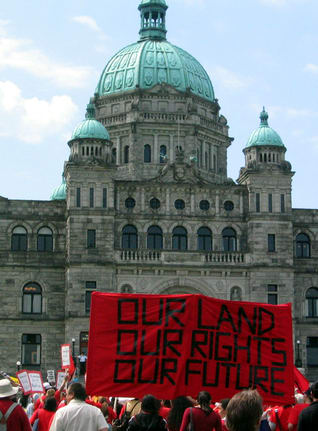
Aboriginal Title and Rights Rally, Victoria, 2004. |
|||||||
 |
||||||||
 |
Indigenous Symposium | |||||||
 |
||||||||
| Day of Action | ||||||||
Source: www.firstnations.eu Printed:
Copyright: All Rights Reserved. Researched, written, compiled, formatted, hyperlinked and encoded by Dr. Karen Wonders. Images and intellectual property rights reside with the credited owner. Commercial transmission and/or reproduction requires written permission. Use for educational and research purposes requires proper citation.

